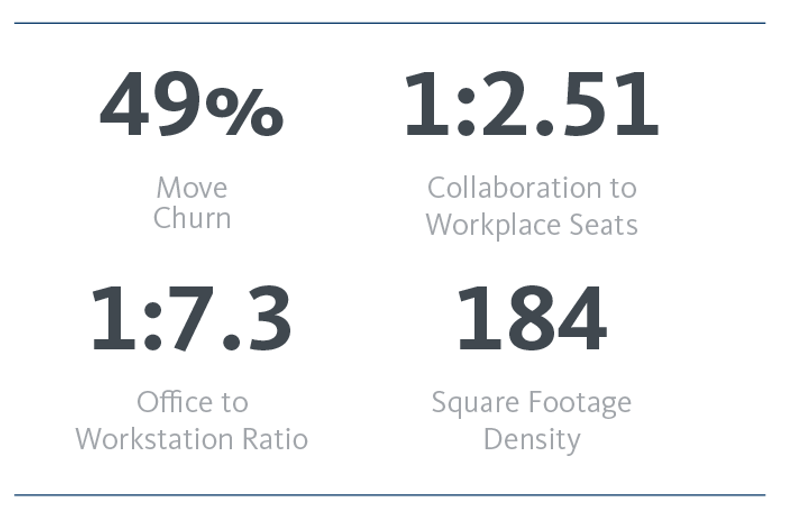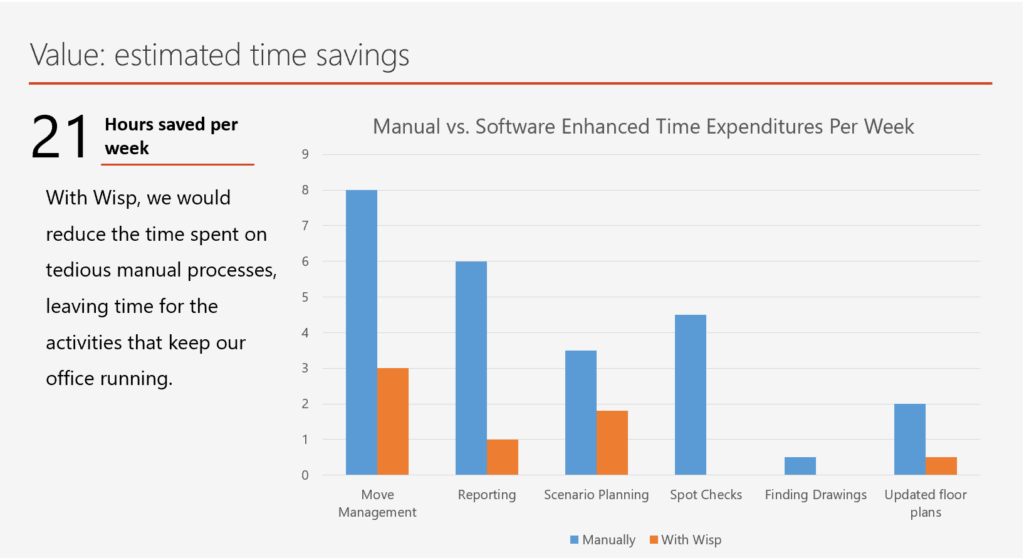An effective business case for space management software begins and ends with reliable information and setting clear expectations.
Quantifying and communicating the value of software to decision makers can be time consuming and tedious. If space management software is on your wish list for the next fiscal year, now is the time to start building your business case.
The core components of a successful space management software business case include key benefits, costs, value, expectations, and project scope.
Having helped many clients communicate the value of space management to their leadership over the years, we’ve outlined the top ten pages to include in your business case for space management software. This can be used as a guide to create your own document to present to leadership.
To get a copy of our free customizable PowerPoint template with all of the following information and more, please schedule a demo to get started.
The top 10 pages to include in a business case for space management software are:
Page 1. Cover Page
- Start with a clear title such as, “Business Case for Space Management Software”
- Include your company’s name, date, and who prepared the document
- Use your brand colors, fonts, and logo
Page 2. Introduction to Space Management
Provide a brief introduction to the topic, including research or data to back up your points. Example:
Space and occupancy data are foundational datasets for understanding inventory and measuring demand on space. Maintaining a central repository of floor plans as a sole source of truth throughout the real estate life cycle creates flexibility for layering a multitude of additional qualitative and quantitative datasets to inform and measure the effectiveness of workplace strategies.
Most organizations have hidden potential in the workplace, and measuring multiple dimensions of space—vacancy, occupancy ratios, space efficiency and more—is the best way to activate one of the greatest assets that may be hiding in plain sight.

Tracking and reporting on our space metrics will inform our current and future workplace strategies.
Page 3. Key features
Outline the key features of space management software that you are proposing.
Space Management
-
- Reporting and analytics
- Data exports
- Service requests
- Lease management
- Rent allocations
- Service and support
- Resource tracking
- Desk reservations
Floor plans
-
- Layer Management
- Color coding
- Seating assignments
- Wayfinding
- Drag and Drop Icons
- Neighborhoods
- CAD updates and polylining
- Mobile wayfinding
Move Management
-
- Workflow advising
- Configurable templates
- Automated notifications
- Move sheets
- Corporate relocation planning
Space Planning
-
- Blocking scenarios
- Seating Assignments
- Departmental controls
- Move Sheets

Page 4. Benefits to your organization
Detail the benefits that your organization will experience. These may include, but are not limited to:
- Develop and maintain our back to the office COVID strategy
- Implement and manage a workplace strategy (i.e. agile, free address, 1:1)
- Consolidate, relocate, merge, or restack space efficiently
- Reduce wasted office space by identifying and optimizing its usage
- Increase data integrity for reporting and decision making
- Consolidate processes and streamline operations for moves, adds, changes
- Shared user access will allow people to manage and track occupancy data simultaneously
- Centralized floor plans and occupancy data will allow us respond quicker to questions
Pages 5-6: Value statements
Quantify and communicate the value of investing in a new software.
Estimate time savings: Compare manual versus software-enhanced time expenditures per week and estimate a final number of hours saved per week, month, and/or year. You can even assign a dollar amount to your teams’ time to quantify the cost savings of reducing manual tasks that can be automated or streamlined with software.
Here’s how this looked for one client. Please note this chart and the numbers will vary based on your weekly tasks and the size of your team and organization.

Clearly articulate what you will do with the extra time. This may include, but is not limited to tasks such as:
- Improve service request response time
- Prepare and maintain meeting space on regular bases
- Stock and maintained the break rooms
- Provide detailed reporting for decision making
- Maintain building equipment
- Budget forecasting
Page 7: Implementation fee components and considerations
Include all of the costs considerations for implementing the software. Consider items such as:
- Software
- User licenses
- Application configuration and consulting
- Project management
- Advisory workshops
- Status meetings
- Drawing production
- User training sessions
- Total Cost
Page 8: Annual fee components and considerations
Include everything that may incur an ongoing fee. Consider items such as:
- Software upgrades
- User Licenses
- Hosting
- Application advising
- Technical Support
- Floor plan updates
- Data monitoring and advising
- Additional training sessions
Page 9: Summary
Summarize your findings and recommendation. Example:
“In closing, we recommend moving forward with [name] as our solution of choice. We chose [Wisp] because the bundled software, implementation services, training and support team, CAD maintenance, and features meet all of our requirements, while we will benefit in the other ways listed in this document.”
Page 10: Next steps
Communicate expectations and next steps. Consider including a detailed implementation timeline and proposal as an appendix. Example:
“The included proposal document details the implementation timeline and costs of Wisp. We are seeking approval to begin implementation on Month, Date per your approval.”
Building a business case takes time and research.

You can use these tips to build you own business case, or you can use our free customizable PowerPoint template, as depicted above. Our framework outlines the time and cost savings of space management software and organizes your business case for leadership. With over ten customizable pages, you’ll be prepared with:
- The benefits of space management
- Features checklists
- Charts and graphs to quantify time savings
- Fee and comparison charts
To get your copy of the Business Case Builder Template, please schedule a demo. Our team will walk you through the template and show you how to customize the charts and graphs—then it’s yours to keep.

